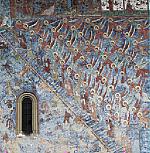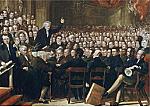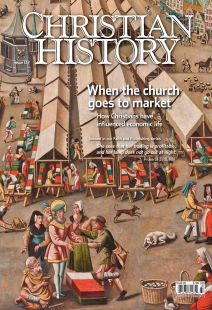Brood of vipers or avenue for flourishing?

[Schloss Ratibor—Museum: Caricature of the heavenly punishment of usurers in Swabia in 1817. Wolfgang Sauber / [CC BY-SA] Wikimedia]
Were John Chrysostom (c. 347–407) invited to preach in today’s churches, he might rail against the satanic nature of credit cards. “For never does the money-lender enjoy his possessions, nor find pleasure in them,” John announced to his congregation in his Homily 56, “for he is grieved that the interest has not yet come up to the principal. And before this evil offspring is brought forth complete, he compels it also to bring forth, making the interest principal, and forcing it to bring forth its untimely and abortive brood of vipers.” He might even set a Mastercard on fire for effect.
Those who bristle at the compound interest of credit cards or the quicksand of payday loans find good company with Christian reformers of the past. The broader church has always viewed debt as a serious peril and lending as a practice requiring strict moral scrutiny.
The church’s passionate yet shifting position centers around usury, the charging of interest. Biblical injunctions against usury were applied straightforwardly for 1,000 years. But in the expanding commercial systems of the High and late Middle Ages, clamping down on usury began to look like whack-a-mole: as each form was prohibited, a new one arose to take its place. Finally, with the emergence of market-based economies, Christians softened their critique, even going so far as to create new forms of finance.
The lender’s bite
Debt, meaning any financial obligation, goes back as far as written records. In ancient civilizations the default means of exchange was some form of debt-and-credit system (not barter, contrary to popular opinion). Interest-free lines of credit existed. Alas, so did predatory loans with unfavorable terms.
The Old Testament teems with warnings about any amount of interest. In traditional economies interest-bearing loans were punitive; not coincidentally the Hebrew word for interest (neshek) means “bite.” Charging interest denoted deceit, extortion, and the ensnaring of people in debt slavery—at odds with the ethos of the Exodus. Accordingly only 0 percent loans were permitted among Israelites. Charitable giving was commended, limitations on collateral were enforced, and options for redemption were provided. Most strikingly the Torah mandates debt forgiveness each seventh year and the return of land in the year of Jubilee.
In the New Testament, a pall hangs over money-changing at the temple, debt slavery, and the grim reality of debtors’ prison. Jesus commended debt relief practices far more generous than those prescribed in the Law, including optional repayment of loans and radical almsgiving. Early Christianity’s ethic of love was in tension with lending practices of the first century, leading Paul to write, “Let no debt remain outstanding except the constant debt to love one another” (Rom. 13:8).
The church fathers were united in their blanket condemnation of usury, which they understood as a violation of the spirit of brotherhood and a peril to the poor. For instance, Cyprian of Carthage condemned backslidden church leaders who forsook their divine calling to become instead “agents in secular business . . . increas[ing] their gains by multiplying usuries.” Early bishops and theologians taught that trade was a good from God, but wealth was something to be shared. Interest-driven banking, while legal in Roman society, remained taboo among churches.
Not that prohibitions stopped all Christians from entering the lending profession. The rising public favor of the church after 313 led to membership growth, including wealthy families and those with careers in finance.
In response teaching grew more strenuous. The Council of Nicaea (325) forced clergy out of the lending business, claiming that the charge of as little as 1 percent on loans was grounds for demotion. Ambrose of Milan (c. 340–397) warned his hearers about loan debt, asserting that lenders are “parasites” guilty of robbery and murder. He implored his hearers to abstain from taking on debt, saying indebtedness is like trying to heal a wound with an ulcer.
In eastern Christendom during the early Middle Ages, the Code of Justinian capped interest at 8 percent, and Byzantines restricted the lending profession to the laity. In areas conquered by Islamic armies, clever credit systems among merchants replaced banking contracts. In the West interest-bearing loans were even less socially acceptable. Charlemagne banned usury altogether in the early 800s. Preaching was likely not the key factor here; loans dried up with shrinking cities and decentralizing society. New relationships between local lords and tenants formed, relationships that conveyed deep social indebtedness—albeit not in monetary, contractual terms. Usury no longer lurked as a great threat. Or so it seemed.
Big risks, bigger profits
Signs of new civic and economic vitality rose in the eleventh century. Peasants and merchants looked for streams of credit. Lords and kings hoped to finance wars and lavish lifestyles and to mobilize armies for the Crusades. With demand for interest-based money, who would take up the morally fraught profession of lending?
Shadowy banking establishments appeared in the High Middle Ages. The Lombards of northern Italy and the Cahorsins of France established themselves as the dominant lenders by the 1100s. Such financiers were by no means highly esteemed, though they were more accepted than Jews (see CH #133). Permitted relatively few medieval professions, Jewish merchants took up loan-making to commoner and king alike.
Predictably, strained relations between creditors and borrowers resulted in anti-Semitic violence, especially when royal borrowers turned to coercion. In 1210, for example, King John ordered an emergency levy from Jews in England. Wealthy Abraham of Bristol held out, so the king ordered that one of his molars be pulled each day until he paid. After seven Abraham surrendered.
Outrageous profits partially offset these terrible risks. Numerous records exist of loans with 40, 60, and even 80 percent interest. In canon law usury by Jews was deemed acceptable via a loophole based on Deuteronomy 23:20, granting Jews the opportunity to use financial violence against “foreigners” in the form of interest. This sometimes resulted in retaliatory physical violence from indebted Gentiles.
Local preachers spread dire tales of torment for usurers in the afterlife, commonly describing the devil filling their mouths with red-hot coins. On the academic front, Thomas Aquinas (1225–1274) claimed that interest is against nature because it is not fruitful (money of itself does not create anything) and borrowers are charged twice (for the thing and again for the use of the thing). Church councils chimed in too. The Second Lateran Council (1139) denied a Christian burial to professional lenders, and the Council of Vienne (1311) decreed that the usurer is to be “punished as if a heretic.”
Looking for loopholes
Prohibitions notwithstanding loans were in demand. Christians sought workarounds, some as comical as they were complicated. IOU “tallies” were issued, and bills smuggled in fees for buying on credit. “Triple contracts” recast interest as three premiums. Lenders tried commanding a flat fee for lending, imposing penalties for late payments, or issuing a surcharge.
If social reformers could not preach usurers out of existence, they could try to undercut them. In 1361 Bishop Michael Northburgh established a charitable bank in London that made 0 percent loans to the poor. A century later Franciscans founded a series of pawnshops, the Montes Pietatis, where the poor could obtain interest-free loans.
Kings and clergy failed miserably when they tried to ban debt outright, but were relatively successful in restraining abuses. In the East Byzantine law capped loans at various rates, permitting 16.6 percent only on the riskiest loans. In the West popes consistently stood against what they called “immoderate interest.”
By the time of the Protestant Reformation, debt was not vilified so much as controlled. In Geneva John Calvin (1509–1564) conceded that, as rent on capital, interest must be governed by “the principle of equity.” The city council of Geneva permitted a 6.7 to 7 percent rate in the middle of the sixteenth century. Yet Calvin continued to doubt that Christian love of neighbor permitted money-lending as a trade, and his successor, Theodore Beza (1519–1605), urged the prosecution of lenders charging over 10 percent.
Usury had then come to mean “excessive interest” rather than the charging of interest per se. Within Roman Catholicism the School of Salamanca (see p. 49) laid groundwork for modern price theory. On the Protestant front, Claude Saumaise (1588–1653) published a defense of moderate interest rates in 1630. He argued that interest is justifiable on account of the lender’s inability to use the money and the risk of loss inherent with a loan, concluding “I would rather be called a usurer than be a tailor.”
Even if usury had gained some level of public acceptance, it was still seen as dangerous to the soul. A popular story in England in the 1600s concerned a notorious usurer who, on his deathbed, kept chewing as if something were in his mouth; he explained that the devil kept stuffing money into his mouth, forcing him to devour it. For borrower and lender alike, the church’s mission was saving people from the consuming jaws of the debt industry.
Soon market-based systems resulted in an explosive growth of wealth, along with technological innovation and class mobility. But free markets came with attendant threats: monopolies, displacement, and inequality. To be part of a capitalistic system was, by default, to interface with lending and debt. Christian philosophers helped explicate this new economy, including the necessity of lending.
Yet anxiety persisted. One Christian response was familiar: cap interest rates. Puritans in North America permitted only single-digit interest rates; later, most US state governments adopted a 6 percent ceiling.
Unfortunately debtors’ prisons, where those who defaulted on loans experienced brutality, rape, illness, and starvation, also expanded. Bookseller and printer Moses Pitt shocked English audiences by describing inmates who ate mice to survive. Non-Christians and Christians alike protested these prisons, which were mostly eradicated by the middle of the nineteenth century. International missionaries spread similar reforms.
Some explored the possibility of loving neighbor with low-interest-rate loans. Moved with Christian compassion for poor German farmers fleeced by loan sharks, Friedrich Wilhelm Raiffeisen (1818–1888) developed an early form of modern credit unions. He emphasized self-help, self-governance, and self-responsibility and loaned funds locally at reasonable rates. Many followed suit. Later “microloans” were also organized in large part by believers. Opportunity International, founded in 1971, provides low-interest loans to help the poor start small businesses. Syrian Christian churches spearheaded microlending efforts in south India, and Christian relief organizations added economic intervention programs to their ministries.
Life-giving lending?
Christians today continue to protest unjust lending. Some are fighting development loans given to Latin American dictators, resulting in high-interest debts forcibly collected once the dictator is overthrown. Local US churches have pursued financial reform. In South Dakota in 2016, for example, a church-championed initiative to cap interest rates on payday lending succeeded, halting loans with an average APR of 574 percent!
Some leaders, like the popular Dave Ramsey, still urge Christians not to get embroiled in any kind of debt. But over the past millennium, fumbling forward, Christians have tolerated and even promoted well-crafted forms of lending. With the proper terms, they argue, debt can be manageable. Indeed it can be empowering. Without abandoning caution, they hope for better debt. CH
By Nathan Hitchcock
[Christian History originally published this article in Christian History Issue #137 in 2020]
Nathan Hitchcock runs the educational consulting firm Sevensided Consulting. He is author of Karl Barth and the Resurrection of the Flesh, and instructs at various schools in the fields of history, theology, and business ethics.Next articles
The undeserving poor
Early Christians emphasized doing good for all, whether or not they were worthy
Daniel F. CanerMisunderstood missionaries
Colonial enablers or pioneers of social and economic reform?
Robert D. WoodberrySupport us
Christian History Institute (CHI) is a non-profit Pennsylvania corporation founded in 1982. Your donations support the continuation of this ministry
Donate





